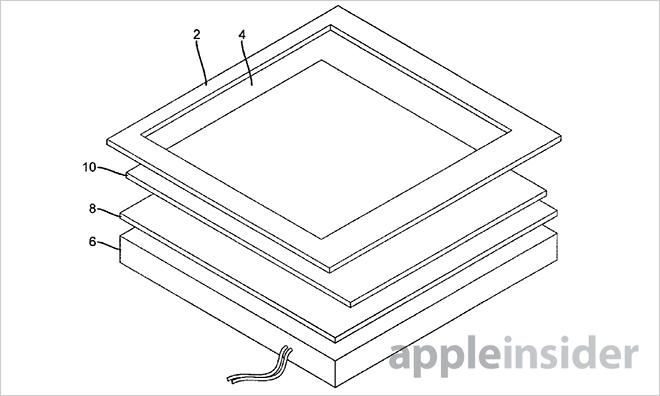The U.S. Patent and Trademark Office on Tuesday granted Apple a patent for a touch-sensitive bezel that can serve as a secondary mode of input for devices with small screens, as well as change from transparent to opaque upon sensing a user's finger.
Apple's U.S. Patent No. 8,477,114 for "Electronic device, display and touch-sensitive user interface" describes a method of deploying a touch-sensitive bezel which extends over a portion of a portable device display, and can hide or reveal that area on command.
The patent describes a system in which a portable device's display is partly overlapped by a touch-enabled bezel that is either partially, or entirely, light-transmissive. In the patent, the screen is split into two sections, the uncovered "active viewing area" and the covered "second portion" of the display.
When embedded sensors detect a finger is in close proximity or touching the device, signals from the controller trigger the second portion to illuminate, thereby changing the appearance of the overlaid bezel. The patent outlines a number of bezel state changes, including simple color-changes and light transmission, to more complex embodiments where the bezel itself turns from opaque to transparent.
For example, the second portion to illuminate briefly to indicate a touch or near touch, or may remain lit until a second touch event is detected.
Illustration of display with active area (62), sensor (73), second screen portion (68) and bezel window (66).In this implementation, the extended bezel area serves as a type of window through which a user can see the device's display. The bezel can be made from a number of materials such that the window disappears from view when the second portion of the screen is not illuminated. Thus an illlusion is created where the window portion of the display is "hidden" until a user triggers a touch event.
According to some embodiments, color changes and text or graphics can be displayed in the second portion of the display which, in concert with the bezel's touch-sensitive capabilities, can create a secondary form of input.
Any number of masking technologies can be applied to the bezel window, though the patent notes circular polarizers or electrowetting techniques as particularly viable potential candidates. In non-portable applications where power consumption is not a critical issue, plasma technologies can be applied.
Top-down view of display with bezel window.Interestingly, the property appears to be from Apple's recent Kodak patent buy, as the application was divisional application to an invention assigned to the struggling photography pioneer. The technology jibes with other Apple patents regarding touch-sensitive or otherwise interactive bezels, however, including one dating back to 2006.
While mere speculation, the patent could conceivably be used in a wearable computing device, allowing for pleasing aesthetics while maximizing utility. Apple is widely rumored to be planning a wristwatch-like product, dubbed the "iWatch," which many believed will be dominated by a multitouch screen. Most recently, the company has been on a worldwide "iWatch" trademark application spree after making a number of filings earlier in June.
Apple's "smart bezel" patent was first filed for in September 2012 and credits Michael E. Miller, Jerald J. Muszak and Michael J. Telek as its inventors.
 Mikey Campbell
Mikey Campbell







-m.jpg)






 Charles Martin
Charles Martin
 Christine McKee
Christine McKee
 Wesley Hilliard
Wesley Hilliard
 Malcolm Owen
Malcolm Owen
 Andrew Orr
Andrew Orr
 William Gallagher
William Gallagher
 Sponsored Content
Sponsored Content








27 Comments
1. What? No rounded corners? Ah, the top-down pic has those. 2. If Apple is indeed implementing this, wait for the competition to do the same, saying it's just a logical and natural thing to implement. Just like build-in batteries and unibody design. Yeah Apple, just patent every piece you guys are tinkering on. It might just help the competition, creating the need to innovate themselves as well.
The 3 inventors listed on this patent are from NY/NJ. I didn't know Apple had corporate employees working on the east coast. I thought all corp employees in the US were in California, Austin and Orlando.
iAd is in NY.
Idea: Why not just dispense with the bezels altogether and have an edge to edge display? You could have sensors along each edge which would intelligently know when you were just holding it or wanted to interact with things along the edge. I think it would look really futuristic and put them way above the competition if they could do this. In addition it would cut down on weight.
Looks like they already have square tablets at IL: [IMG ALT=""]http://forums.appleinsider.com/content/type/61/id/27796/width/500/height/1000[/IMG]